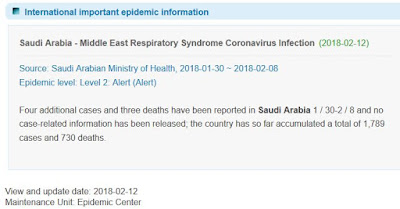#13,140
Yesterday, in Saudi MOH: Mismatching MERS Reports, we looked at the missing and mismatched daily MERS-CoV reports from the Saudi MOH since late January.
As of today (Feb 12th) - since January 29th - only 2 days (no cases) have been reported on the English language report, while 3 days (1 case) have been reported on the Arabic side (see graphic above).As mentioned by Crof on Saturday, there have been murmurs on Arabic social media for several days regarding a suspected hospital outbreak in Hafar Al-Batin, and I posted an (unconfirmed) news item yesterday from Feb 7th:
The death of a citizen and wounding three Mkhaltin b «Corona» in the drilling sub
«Health» has taken precautionary measures to counter the virus (today)
Manis Al Shehhi - Hafr Al Baten
The Directorate of Health Affairs in Hafr al-Batin closed Tuesday a conservative hospital after a 67-year-old citizen died of the Corona virus and three others were injured in the hospital.
(Continue . .. )As of 7:30 am EST today, the English Saudi MOH site remains the same as I reported yesterday, with no new updates, and no cases reported since January 28th.
Adding some credibility to the social media chatter, and the Arabic media story above, we have the following brief epidemiological announcement which appears on the Taiwan CDC's list of International important epidemic information (see translated screen shot below), indicating 4 cases and 3 deaths between January 30th and Feb 8th.
While not a particularly alarming report, it does beg the question of what is behind the recent delays in reporting?
We've seen much larger clusters freely reported by the MOH in the past, but over the past few months, case reports have often been delayed, intermittently posted, and sometimes omitted from their public reporting.Even with complete, timely reporting we'd only likely learn about a fraction of the MERS cases in KSA. Many cases are mild, and some are asymptomatic. Those are unlikely to be tested, identified, and reported.
We've previously looked at estimates that have suggested the number of MERS cases far exceeds the numbers reported by countries on the Arabian Peninsula.
- In November of 2013, we looked at a study published in The Lancet Infectious Diseases, that estimated for every case identified, there are likely 5 to 10 that go undetected.
- Last year when Saudi Arabia had recorded fewer than 1200 MERS cases, a seroprevalence study(see Presence of Middle East respiratory syndrome coronavirus antibodies in Saudi Arabia: a nationwide, cross-sectional, serological study by Drosten & Memish et al.,) suggested nearly 45,000 might have been infected.
- And a 2016 study (see EID Journal: Estimation of Severe MERS Cases in the Middle East, 2012–2016) suggested that as much as 60% of severe Saudi MERS cases go undiagnosed.
Despite this recent uptick, and recent gaps in reporting, the good news is we've seen no signs of any sustained or efficient transmission of the MERS virus outside of health care facilities.
That said, there have been some signs suggesting the MERS virus has gotten a little better at transmitting in the community (see Study: A Pandemic Risk Assessment Of MERS-CoV In Saudi Arabia).Hopefully we'll start getting more complete and timely updates from the MOH soon.

